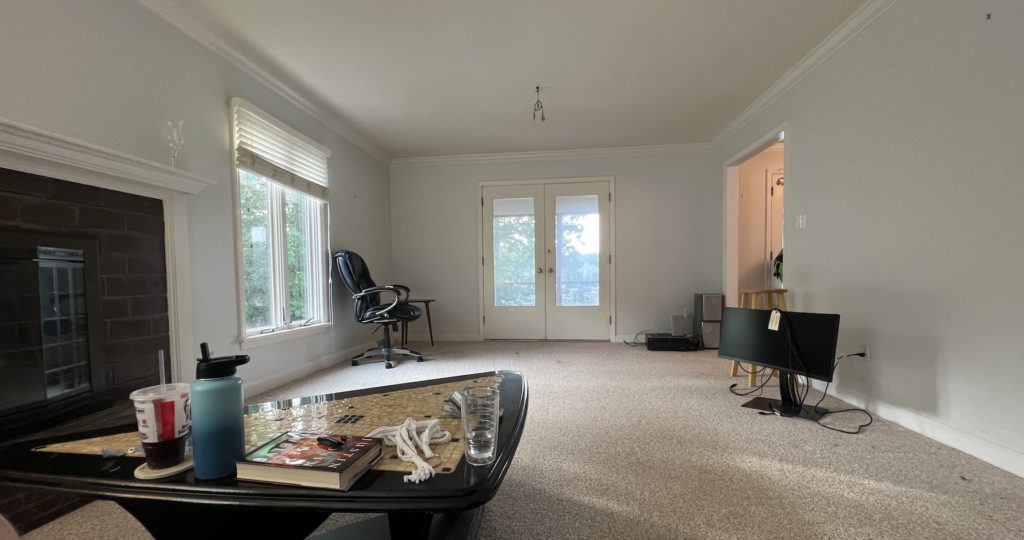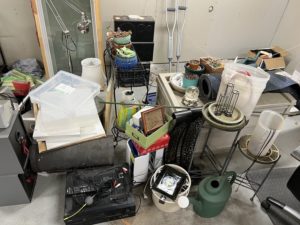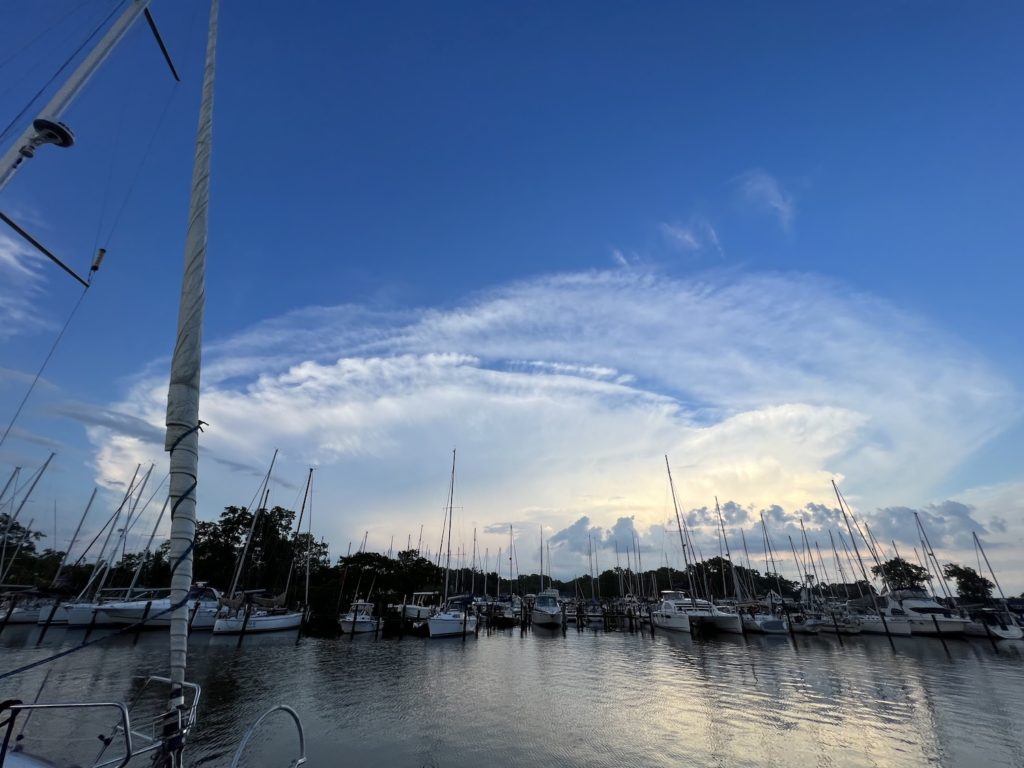We are 99.9% complete with The Great Downsize of 2023. With only a couple of items left in the house, we have successfully rid ourselves of all the belongings we’re not keeping long-term or taking on the boat. How did we do all of this? What has it been like? How did we decide what to do with everything?
To say this has been a long and arduous path would be an understatement. We had lived in the current house for 12 years and had another ~10 years of stuff accumulated as adults. In addition, we had keepsakes from our childhoods and heirlooms from our family. We had things in every closet, cabinet, nook, and cranny of that 3500sq ft house. And now: none of it is there.
This process started in 2021 when we began clearing the house of our unused stuff. While we didn’t have a boat purchase timeline, we knew downsizing would take a while. Additionally, we knew it would sometimes be painful to let go of our treasures. For guidance, I bought the course, Downsizing for Life Afloat. I also googled how other people disentangle themselves from many years of land life. Of course, I found our friends at Sailing Totem had written about it for Cruising World. In short, there are tons of resources to help in this kind of transition.

Our Goal
Our main goal was not to have a storage unit. We knew there were a few things we wanted to keep, and we enlisted family who had space (and willingness) for those few things.
What was the process?
In short, the process was reasonably straightforward. The work was hard.
- Clean out the trash
- Giveaway the usable and low-value stuff
- Sell what we can
How that process played out in reality:
- Clean out the trash.
- Clean out the junk.
- Clean out the trash. Seriously, be honest about what’s not usable! For example, I went several rounds before finally throwing away my tattered baby blanket.
- Identify and sell the valuable stuff (silver, electronics, etc.)
- Clean out the junk. Yup – again. More honesty is required.
- Sell more of the not-junk. Seriously, sell your heirlooms and other treasures!
- Give away what’s left and usable.
- Clean out the trash. Yup – there’s stuff that I thought someone SHOULD value and use, and it ended up being trash**.
Selling Our Stuff
In late 2021, I began selling items on Poshmark, Facebook Marketplace, and eBay. This approach maximized the profit because we had time to find the right buyer at higher prices.
eBay was best for selling anything shippable. That included old electronics, anything sterling silver, and other collectibles. While eBay takes a cut, we still made more money on many items than I would have if we had held an estate sale.
FB Marketplace was great for furniture, musical instruments, and anything else bulky. We generally still took less profit because we sold items for less due to the smaller local market. I also used Craigslist and OfferUp with varying success.
Poshmark was great for high-dollar clothing. Low-value clothes can sell there, but you have to spend time promoting your items in live shows and promoting other Poshers. Your mileage may vary.
Estate Sale & Final Cleanout
The estate sale ended up being a no-go for us. By the time we were ready to hold an estate sale, we had sold enough of our goods to reduce the value for the estate sale companies. Those companies spend a lot of effort sorting, displaying, and photographing the goods and furniture in a home, which means they need to make enough money to cover the labor AND take their cut of the profit.
In addition to selling our stuff, we opened our home to our family members. We wanted our stuff to make a difference in their lives, if possible. While that’s entirely out of our control, giving them goods and supplies is one more bit of good energy we can put out in the world.
To complete our cleanout, we connected with a local liquidator, a small business that makes money re-selling goods like ours at a flea market. We made some money because he could salvage stuff we couldn’t sell. He brought in a partner to do the final trash haul of all the items he couldn’t take.

What did we keep?
As I said earlier, we had a few things that we wanted to keep for when we returned to land life (maybe in 10 years).
Here’s the shortlist:
- Our art collection. While we don’t have any Monets or Rembrandts, we have pieces we love and art from Charles’s Grandmother Ione and Pinky’s Great-Grandfather Buckley.
- The vintage cathedral radio from Pinky’s great-grandfather
- A vintage side table from Pinky’s great-uncle
- Two club chairs from Pinky’s grandmother
- One storage tub with journals, a few books, and a handful of trinkets
What about all the photos? We digitized as much as possible. We converted family records, photos, and all other documents into digital assets we could sort and organize in a digital library. Not only does this save space, but it also creates a more robust inheritance strategy. The future generations of our family won’t want to sort through 10,000 photos or 100 slides (remember those?!). How would they know the stories behind the images? By digitizing family history, we can better document, preserve, and pass down the records and memories.
The Completed Downsize
In the last two weeks, the last of our goods left our land house. At times, we feel grief for the end of this lifestyle, the loss of our things (even if intentional), and the closing of the land-life chapter. At other times, we feel excitement for the future and the freedom that comes with shedding the attachment to things.
According to the Four Noble Truths book on Dharma Talks (and other sources), “The Buddha identifies the origination of suffering as any craving that leads to further becoming, accompanied by passion and delight, delighting now here, now there.” While we are not Buddhist, this idea of suffering’s origin is a powerful statement relative to what we’re experiencing.
Craving these things leads to suffering in this process. If we give in to the craving to keep our things (in storage or at a friend’s house), we keep ourselves from “further becoming.” That means we continue to tie ourselves to things that serve no in-the-moment purpose while living on a sailboat.
When we disconnect from the craving, we see the true value of those things with open hearts. They are things. Most are replaceable. We were craving the Kitchenaid mixer, the mortar & pestle, the Uplift standing desk, the custom engraved pizza peel, and the 90-year-old club chairs from my Great-Grandmother that needed reupholstering. What would we do with those things? Even in 10 years?!

Let Go and Be Free
The lesson for us is to let go. And in letting go, we find freedom. We are free from worrying about someone stealing from the land house. We are free from the emotional bonds of the material things we once had in our land house. We are free from worrying about what will happen to that stuff when we die.
Let’s Cast Off, Then!
At the same time, we have not cast off the dock and sailed into the sunset (or sunrise since we’re on the US East Coast). We are still living in a marina. Our house battery bank needs replacing. We can’t unplug from shore power for more than a few hours before running out of electricity. Our anchor windlasses are out of commission, meaning we can’t anchor out anywhere, even with the battery bank repaired.
We are now conscientious of our craving to get out of the marina and into our full-time sailing life. And because we are learning the hard lessons of craving causing suffering, we are mindful to be content with where we are. We are taking action to get off the dock. Progress is slow sometimes, and it’s always one foot in front of the other.dsf
**Because we had a company complete the last bit of the cleanout, I’m unaware of what went to the trash vs. what was donated. Not knowing is painful, but it’s for the best. It’s all out of my control anyway
Discover more from SV Loka
Subscribe to get the latest posts sent to your email.

We have been thinking about you both. Loed reading about the process.
Take care.
Always,
Robin
I’m inspired! I’m in awe of you two. Can’t wait to keep following your adventures. Love to both of you!
Pingback: July 2023 Update: What Are We Up To? – SV Loka
I am thrilled for you to set sail and just ‘be you’ and ‘be happy’.